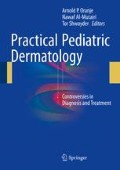Abstract
The skin is the most accessible organ of the human being. It is also the most frequently injured organ in accidents and in child abuse. Skin abnormalities are visible to everyone. The diagnosis of these abnormalities in suspected child abuse, however, is the work of specialists. Diagnostic errors can be prevented through close cooperation between forensic pediatrics and pediatric dermatology.
Ce qu’il y a de plus profond de l’homme, c’est la peau. (Paul Valery, French poet, 1871–1945)
Access this chapter
Tax calculation will be finalised at checkout
Purchases are for personal use only
References
AlJasser M, Al-Khenaizan S. Cutaneous mimickers of child abuse: a primer for pediatricians. Eur J Pediatr. 2008;167(11):1221–30.
Bays J. Conditions mistaken for child physical abuse. In: Reece RM, Ludwig S, editors. Child abuse, medical diagnosis and management. 2nd ed. Philadelphia: Lippincott Williams & Wilkins; 2001. p. 177–206.
Bilo RAC. Forensic pediatric dermatology: my skin is only the toplayer of the problem. In: Oranje AP, de Waard – van der Spek FB, Bilo RAC. Dermatology from young to old. Zwolle: Isala series nr 43; 2003. p. 45–52.
Bilo RAC, Oranje AP. Physiological habits, self-mutilation and factitious disorders. In: Harper J, Oranje A, Prose N, editors. Textbook of pediatric dermatology. 2nd ed. Oxford: Blackwell Publishing; 2006. p. 2096–109.
Bilo RAC, Oranje AP, Shwayder T, Hobbs CJ. Cutaneous manifestations of child abuse and their differential diagnosis – blunt force trauma. New York: Springer; 2013.
Bouvet R, Pierre M, Toutain F, et al. Tufted angioma with Kasabach-Merritt syndrome mistaken for child abuse. Forensic Sci Int. 2014;245C:e15–7.
Boyd AS, Ritchie C, Likhari S. Munchausen syndrome and Munchausen syndrome by proxy in dermatology. J Am Acad Dermatol. 2014;71(2):376–81.
Cantatore-Francis JL, Cohen-Pfeffer J, Balwani M, et al. Hepatoerythropoietic porphyria misdiagnosed as child abuse: cutaneous, arthritic, and hematologic manifestations in siblings with a novel UROD mutation. Arch Dermatol. 2010;146(5):529–33.
Carlsen K, Weismann K. Phytophotodermatitis in 19 children admitted to hospital and their differential diagnoses: child abuse and herpes simplex virus infection. J Am Acad Dermatol. 2007;57(5 suppl):S88–91.
Cyrulnik AA, Dawkins MC, Smalberger GJ, et al. Kaposiform hemangioendothelioma with Kasabach-Merritt syndrome mistaken for child abuse in a newborn. Cutis. 2014;93(3):E17–20.
Elder DE. Interpretation of anogenital findings in the living child: implications for the paediatric forensic autopsy. J Forensic Leg Med. 2007;14(8):482–8.
Fortin K, Jenny C. Sexual abuse. Pediatr Rev. 2012;33(1):19–32.
Harth W, Taube KM, Gieler U. Factitious disorders in dermatology [Article in English, German]. J Dtsch Dermatol Ges. 2010;8(5):361–72.
Harth W, Linse R. Dermatological symptoms and sexual abuse: a review and case reports. J Eur Acad Dermatol Venereol. 2000;14(6):489–94.
Hobbs CJ, Hanks HGI, Wynne JM. Physical abuse. In: Hobbs CJ, Hanks HGI, Wynne JM, editors. Child abuse and neglect – a clinician’s handbook. 2nd ed. London/New York: Churchill Livingstone; 1999. p. 63–104.
Hobbs CJ. Physical evidence of child sexual abuse. Eur J Pediatr. 2012;171(5):751–5.
Hornor G. Common conditions that mimic findings of sexual abuse. J Pediatr Health Care. 2009;23(5):283–8.
Johnson CF. Dermatological manifestations. In: Levin AV, Sheridan MS, editors. Munchausen syndrome by proxy – issues in diagnosis and treatment. New York: Lexington Books; 1995. p. 189–200.
Kempe CH, Silverman FN, Steele BF, et al. The battered-child syndrome. JAMA. 1962;181:17–24.
Kirschner RH, Stein RJ. The mistaken diagnosis of child abuse. A form of medical abuse? Am J Dis Child. 1985;139(9):873–5.
Kotik A, Zaitsev K, Shperber A, Hiss J. [The prevalence of physical evidence in the anogenital area in sexual assault cases of children in Israel] [Article in Hebrew]. Harefuah. 2011;150(12):895–8, 936.
Libow JA. Child and adolescent illness falsification. Pediatrics. 2000;105(2):336–42.
Oranje A, Bilo RA. Skin signs in child abuse and differential diagnosis. Minerva Pediatr. 2011;63(4):319–25.
Patnaik S, Mishra BR, Mohanty I, Nayak S. Foamy discharge on the scalp of the infant: Munchausen syndrome by proxy. Indian J Dermatol. 2013;58(5):410–1.
Ravanfar P, Dinulos JG. Cultural practices affecting the skin of children. Curr Opin Pediatr. 2010;22(4):423–31.
Rosenberg DA. Munchausen syndrome by proxy. In: Reece RM, editor. Child abuse – medical diagnosis and management. Philadelphia: Lea Febiger; 1994. p. 266–78.
Schreier HA, Libow JA. Munchausen by proxy syndrome: a modern pediatric challenge. J Pediatr. 1994;125:S110–5.
Schwartz KA, Metz J, Feldman K, Sidbury R, Lindberg DM, the ExSTRA Investigators. Cutaneous findings mistaken for physical abuse: present but not pervasive. Pediatr Dermatol. 2014;31(2):146–55.
Stankler L. Factitious skin lesions in a mother and two sons. Br Med J. 1977;97:217.
Stanziale SF, Christopher JC, Fisher RB. Brodifacoum rodenticide ingestion in a patient with shigellosis. South Med J. 1997;90(8):833–5.
Sugandhan S, Gupta S, Khandpur S, et al. ‘Munchausen syndrome by proxy’ presenting as battered child syndrome: a report of two cases. Int J Dermatol. 2010;49(6):679–83.
Swerdlin A, Berkowitz C, Craft N. Cutaneous signs of child abuse. J Am Acad Dermatol. 2007;57(3):371–92.
Vennemann B, Perdekamp MG, Weinmann W, et al. A case of Munchausen syndrome by proxy with subsequent suicide of the mother. Forensic Sci Int. 2006;158(2–3):195–9.
Weston WL, Morelli JG. “Painful and disabling granuloma annulare”: a case of Munchausen by proxy. Pediatr Dermatol. 1997;14(5):363–4.
Wheeler DM, Hobbs CJ. Mistakes in diagnosing non-accidental injury, 10 years’ experience. Br Med J. 1988;296:1233–6.
WHO (World Health Organization). Preventing child maltreatment: a guide to taking action and generating evidence. Geneva: World Health Organization and International Society for Prevention of Child Abuse and Neglect; 2006.
Author information
Authors and Affiliations
Corresponding author
Editor information
Editors and Affiliations
Rights and permissions
Copyright information
© 2016 Springer International Publishing Switzerland
About this chapter
Cite this chapter
Bilo, R.A.C. (2016). Child Abuse: More Than Skin Deep. In: Oranje, A., Al-Mutairi, N., Shwayder, T. (eds) Practical Pediatric Dermatology. Springer, Cham. https://doi.org/10.1007/978-3-319-32159-2_16
Download citation
DOI: https://doi.org/10.1007/978-3-319-32159-2_16
Published:
Publisher Name: Springer, Cham
Print ISBN: 978-3-319-32157-8
Online ISBN: 978-3-319-32159-2
eBook Packages: MedicineMedicine (R0)

